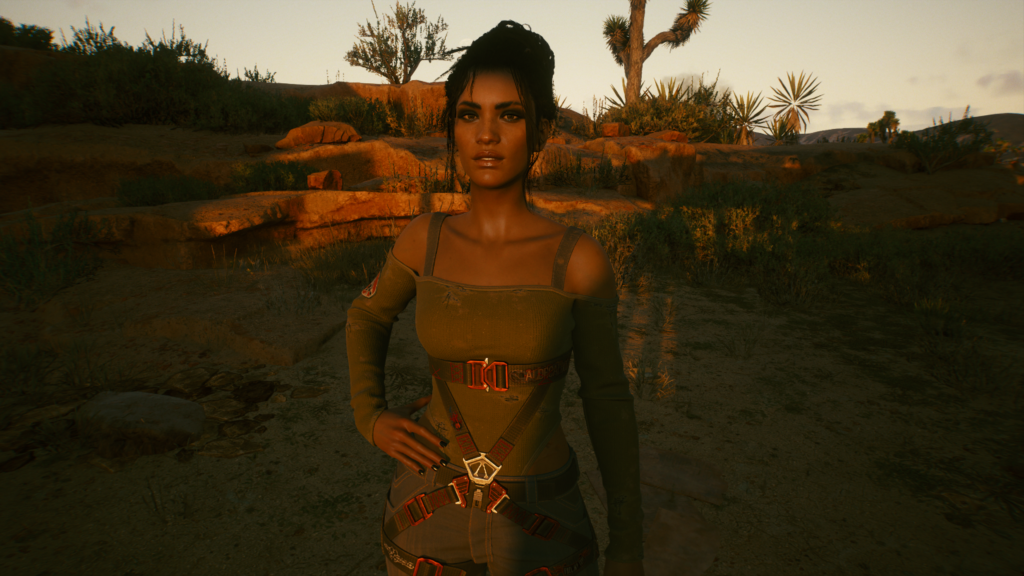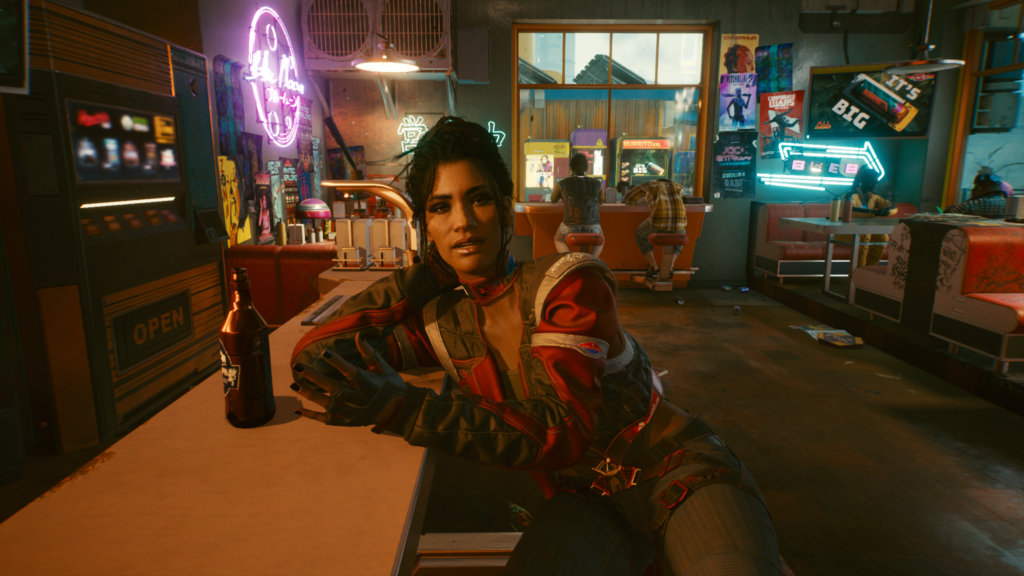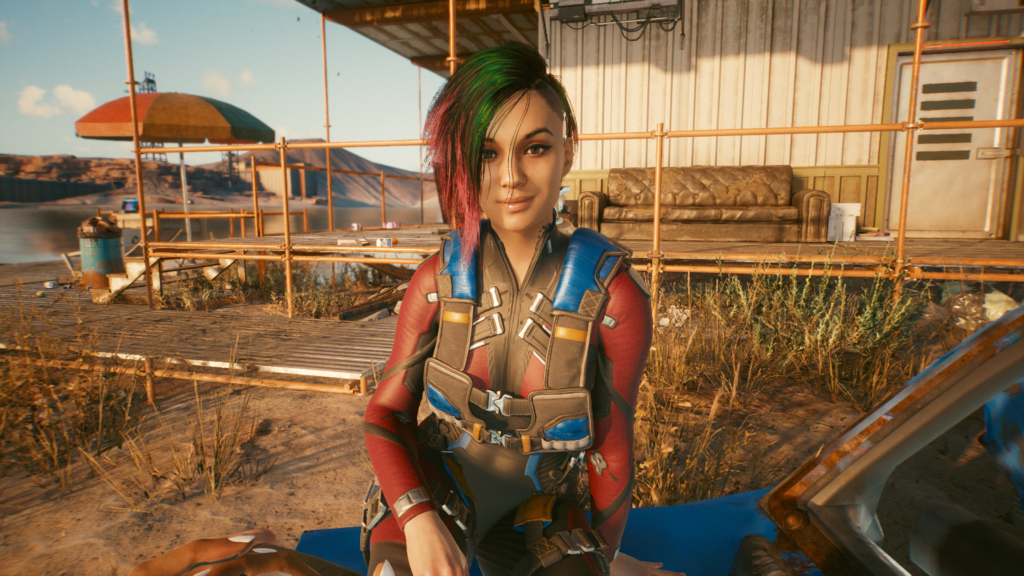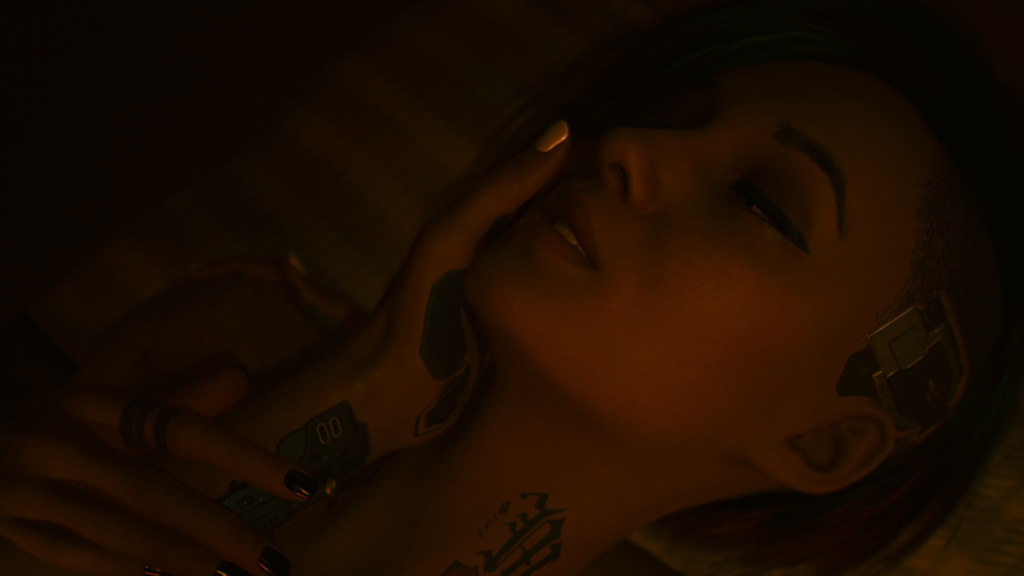
The Cyberpunk 2077 Romances Weren’t Made for Trans People
Fun fact: if you have a penis in real life, when you look down, you can see it! In this game, that’s not the case. That’s because Cyberpunk 2077 is not a game made for trans people. Despite the big fuss made over the fact the game allows you to have different penis sizes and attach them to a feminine body, the game is surprisingly coy about sending you dick pics. There’s a dildo on every street corner, but if you take V’s clothes off and look down, they’ll still be wearing underwear.
This doesn’t really bother me. If you’re desperate to see V’s penis, you can unequip Trousers in the inventory, and on the menu screen, you’ll see their junk flop around beneath their neatly trimmed pubic hair. But it strikes me as odd for a game so loaded with sexual imagery, so keen to show off their genderless genitalia, that they suddenly become shy when it comes to tilting their head down a little.
This isn’t a quirk of game design. This is a deliberate decision, one which is emblematic of the ideas at the core of Cyberpunk 2077’s thinking.
Many trans people have known for some time that Cyberpunk 2077 would not welcome us, after the transphobic dogwhistles of the game’s marketing and the much-discussed Mix It Up poster. It’s understandable though that those who haven’t followed the game closely would have heard about the carefree genital options in the game and thought “Finally! A game where I can be myself!”
It sucks that Cyberpunk 2077 didn’t live up to that. The fact you cannot see your genitals in first person, when it might actually be of personal value, but can see them in third person where you can giggle and give your female character a massive willy is a perfect example of one of the game’s biggest issues: it’s trans people being othered all the way down.
I don’t want to talk about the character creator much here. Once I start, I might not stop. Cyberpunk 2077 is like Pringles, but instead of tasty crisps, it’s me yelling about transphobia. But the background of the character creator is key for the topic I want to explore: the romances.
There are a few different characters you can romance in the game, as well as sex workers (Joytoys in Night City lexicon) you can pay to sleep with you, but I’m going to focus on the two I pursued: Panam Palmer and Judy Alvarez.
While Night City has huge disdain for women in general – another Pringles topic for me – these two female characters are my favourites in the game. But in pursuing romance with them, it became clear that Cyberpunk 2077 was made for a certain type of player, and I just wasn’t it.

First, Panam Palmer. I wasn’t aware of this at the time, but Panam will only go for players who choose the male body. It’s disappointing to be rejected by someone who looks like “if Kesha was in Mad Max”, but I always like characters to have real sexualities. It makes the world feel more real. I’ve played through the Mass Effect trilogy five times, and only once as BroShep; entirely so I could be topped by Jack.
I have no issues with Panam not being into me. Thanks to Cyberpunk 2077 tagging some romance options to body type and others to voice, her sexuality is complicated to define, but in general I have no issues with characters having preferences. The problem is the situation feels so obviously coded for men. Panam relaxes, adopts a sultry tone, puts her feet across you, and jokes about the smell (hey, some people are into that), then as soon as you reciprocate, she sits up and slams the brakes so hard I think my V broke her nose on the windshield. In one particular ending, she even cuddles up to V, regardless of what body type you choose.
In reality, Panam is at liberty to pump the brakes whenever she wants for whatever reason. But in fiction, it’s bad writing to engineer a situation that requires a sudden, sharp stop. However, the fact that the game looked at my moderately endowed V and said “hell no, this chick likes guys!” was a nice, if unintentional, reaffirming moment of my character’s transition.
Still, it felt like the situation was entirely written for romance-eligible men, with women as an afterthought. I later discovered the scene actually always plays out this way, which just feels like weak writing in general, though I’ll take all the reaffirmation from this game I can get. However, if you can pursue Panam, her sex scene heavily implies that your character has a penis, even though she will romance you if you have a male body with a vagina (of which, typical of the game’s design, there is only one option for). So while reaffirming for trans women, it completely dismisses the existence of trans men.

In any case, my attention turned to Judy. Once bitten, twice rabidly-Googling-Cyberpunk-romance-guides, I discovered to my relief that Judy does indeed like girls. However, there’s a catch.
Judy will only be available if you have a female body and a feminine voice. For the record, Panam doesn’t care about your voice, only your masc body, but there is another character who needs masc body, masc voice, and a fourth character who only needs V to have a female body.
To revisit the character creator briefly, gender isn’t tied to genitals, but it’s tied to voice. Initially, I had wanted to create a she/her V with a female body, penis, and masculine voice. But to be she/her, you have to rock the female voice. Ultimately, that was the choice I made, so I faced no roadblock with Judy, but it’s still a design choice which makes me uncomfortable.
At first, I thought it made Judy seem TERFy, but on reflection I think that’s unfair. My V still had a penis, and Judy had no qualms with that. Instead, it’s yet more game design from Cyberpunk 2077 that lets trans people exist as objects but not as people. While there’s some justification in making Panam prefer masc bodies, giving Judy a voice preference makes no sense. I don’t think it’s hateful or transphobic, I just think it’s daft. Tying pronouns to voice is a bad choice and having that directly influence romance options feels more like CDPR digging themselves deeper to justify that choice.
Another angle with Judy’s romance is how it handles men. Since they are locked out by Judy’s sexuality, she will reject men. However, this rejection is ever-present throughout the game, leaving male V’s in no doubt as to who to pursue and who to ignore.

With the flirting out of the way, we move on to the sex. Cyberpunk 2077 is an incredibly explicit game, and the sex scenes are no different. We see that Judy has a spider web tattoo around her nipple, and when she takes V’s hand and moves it down her body, it’s not subtle what’s going on. But the big issue with this scene is that it feels like two cis women having sex.
I’m not asking for the game to show V’s junk in action. The scenes are already a bit too explicit anyway, and that certainly wouldn’t help. But the scenes so clearly ignore the trans experience, to the point where any physical connection to V, any romantic connection to Judy, feels almost impossible. Ditto Panam.
I know that it would have taken much longer to have scenes differ depending on genitals, and that only a small segment of the audience would have benefited. I know these devs were already crunched to death. But they promoted the hell out of a character creator a lot of trans people could see from a mile away wasn’t going to be of any real benefit. I said as much back in June, and I was far from the first.
Like much mass media, trans representation in video games has been rare and almost entirely negative, at least amongst AAA titles, until very recently. The game’s crimes aren’t especially heinous with its attitude towards romances. The marketing of Cyberpunk 2077, on the other hand, felt like a new low, and to fetishise trans people so extremely yet fail to acknowledge their existence is just insulting. Recently though, we have seen games do it better. If Found… is one of many indie trans games actually made by trans people, one which strikes at the heart of what it means to be trans, not just to look trans. Tell Me Why is another which folds the trans experience into every pixel. It’s a shame games willing to be bold in this way never get the financial backing of Cyberpunk 2077.
These trans-exclusionary romance scenes are just another example of trans people existing in the game but never in the developers’ minds. We’re used to seeing more representation – any representation – in games for trans people as a net positive, because we’ve been so starved of it until now. But from a clunky character creator, gendered voices, lack of trans people in Night City’s reality and cis-centric romances, Cyberpunk 2077 feels like a step backwards. For a game set 57 years in the future, a lot of its attitudes feel awfully dated.







